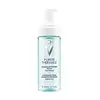What's inside
What's inside
 Key Ingredients
Key Ingredients

No key ingredients
 Benefits
Benefits

 Concerns
Concerns

 Ingredients Side-by-side
Ingredients Side-by-side

Water
Skin ConditioningSodium Laureth Sulfate
CleansingCoco-Betaine
CleansingSodium Lauroyl Sarcosinate
CleansingMannitol
HumectantXylitol
HumectantRhamnose
HumectantFructooligosaccharides
HumectantLaminaria Ochroleuca Extract
Skin ConditioningZinc Gluconate
Skin ConditioningPEG-90 Glyceryl Isostearate
CleansingSodium Chloride
MaskingCoco-Glucoside
CleansingGlyceryl Oleate
EmollientCapryloyl Glycine
CleansingDecylene Glycol
Skin ConditioningCaprylic/Capric Triglyceride
MaskingLaureth-2
CleansingAmmonium Glycyrrhizate
MaskingLysine Azelate
BleachingPyridoxine Hcl
Skin ConditioningUndecyl Alcohol
AntiseborrhoeicCitric Acid
BufferingDisodium EDTA
Sodium Hydroxide
BufferingWater, Sodium Laureth Sulfate, Coco-Betaine, Sodium Lauroyl Sarcosinate, Mannitol, Xylitol, Rhamnose, Fructooligosaccharides, Laminaria Ochroleuca Extract, Zinc Gluconate, PEG-90 Glyceryl Isostearate, Sodium Chloride, Coco-Glucoside, Glyceryl Oleate, Capryloyl Glycine, Decylene Glycol, Caprylic/Capric Triglyceride, Laureth-2, Ammonium Glycyrrhizate, Lysine Azelate, Pyridoxine Hcl, Undecyl Alcohol, Citric Acid, Disodium EDTA, Sodium Hydroxide
Water
Skin ConditioningDipropylene Glycol
HumectantSodium Laureth Sulfate
CleansingGlycerin
HumectantPEG-200 Hydrogenated Glyceryl Palmate
CleansingDisodium Cocoamphodiacetate
CleansingPEG-30 Glyceryl Cocoate
EmulsifyingPEG-7 Glyceryl Cocoate
EmulsifyingPotassium Chloride
Sodium Chloride
MaskingSodium Glycolate
BufferingPhenoxyethanol
PreservativeCoco-Betaine
CleansingDisodium EDTA
Citric Acid
BufferingButylene Glycol
HumectantButyrospermum Parkii Seedcake Extract
Skin ProtectingParfum
MaskingWater, Dipropylene Glycol, Sodium Laureth Sulfate, Glycerin, PEG-200 Hydrogenated Glyceryl Palmate, Disodium Cocoamphodiacetate, PEG-30 Glyceryl Cocoate, PEG-7 Glyceryl Cocoate, Potassium Chloride, Sodium Chloride, Sodium Glycolate, Phenoxyethanol, Coco-Betaine, Disodium EDTA, Citric Acid, Butylene Glycol, Butyrospermum Parkii Seedcake Extract, Parfum
Ingredients Explained
These ingredients are found in both products.
Ingredients higher up in an ingredient list are typically present in a larger amount.
Citric Acid is an alpha hydroxy acid (AHA) naturally found in citrus fruits like oranges, lemons, and limes.
Like other AHAs, citric acid can exfoliate skin by breaking down the bonds that hold dead skin cells together. This helps reveal smoother and brighter skin underneath.
However, this exfoliating effect only happens at high concentrations (20%) which can be hard to find in cosmetic products.
Due to this, citric acid is usually included in small amounts as a pH adjuster. This helps keep products slightly more acidic and compatible with skin's natural pH.
In skincare formulas, citric acid can:
While it can provide some skin benefits, research shows lactic acid and glycolic acid are generally more effective and less irritating exfoliants.
Most citric acid used in skincare today is made by fermenting sugars (usually from molasses). This synthetic version is identical to the natural citrus form but easier to stabilize and use in formulations.
Read more about some other popular AHA's here:
Learn more about Citric AcidCoco-Betaine is the natural version of Cocamidopropyl Betaine. It is often derived from coconuts.
Coco-Betaine is a surfactant, meaning it helps remove dirt and oil from the skin.
Disodium EDTA plays a role in making products more stable by aiding other preservatives.
It is a chelating agent, meaning it neutralizes metal ions that may be found in a product.
Disodium EDTA is a salt of edetic acid and is found to be safe in cosmetic ingredients.
Learn more about Disodium EDTAChances are, you eat sodium chloride every day. Sodium Chloride is also known as table salt.
This ingredient has many purposes in skincare: thickener, emulsifier, and exfoliator.
You'll most likely find this ingredient in cleansers where it is used to create a gel-like texture. As an emulsifier, it also prevents ingredients from separating.
There is much debate on whether this ingredient is comedogenic. The short answer - comedogenic ratings don't tell the whole story. Learn more about comegodenic ratings here.
The concensus about this ingredient causing acne seems to be divided. Research is needed to understand if this ingredient does cause acne.
Scrubs may use salt as the primary exfoliating ingredient.
Learn more about Sodium ChlorideSodium Laureth Sulfate (SLES) is a foaming, cleansing, and emulsifying ingredient. It is created from palm kernel oil or coconut oil. SLES is not the same as sodium lauryl sulfate. It is much milder and less likely to irritate.
SLES helps create foam in personal products. It also prevents ingredients from separating, helping to elongate the shelf life.
Sodium Laureth Sulfate is a type of sulfate. It can be drying. We recommend speaking with a professional about using this ingredient if you have concerns.
Learn more about Sodium Laureth SulfateWater. It's the most common cosmetic ingredient of all. You'll usually see it at the top of ingredient lists, meaning that it makes up the largest part of the product.
So why is it so popular? Water most often acts as a solvent - this means that it helps dissolve other ingredients into the formulation.
You'll also recognize water as that liquid we all need to stay alive. If you see this, drink a glass of water. Stay hydrated!
Learn more about Water